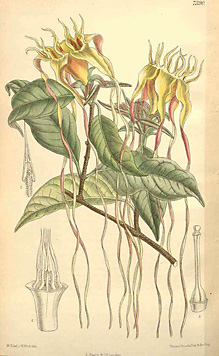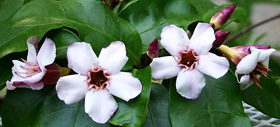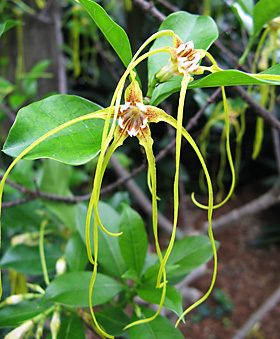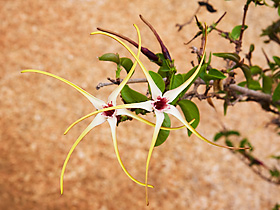





What “long-haired” plant is pretty, perfumed, and poisonous?
Although “stringy” usually isn’t a complimentary adjective, strophanthus is admired for the wavy strings which descend like cascading ringlets from the tips of the petals on many species. Its name, in fact, means “twisted cord flower,” and it comes in a variety of shapes—including vines, shrubs, and trees.

 Not all species sport those steamers. One of the most available, Strophanthus gratus, is known as climbing oleander because its 2-inch, pink-flushed white flowers resemble those of oleander. It does have long “eyelashes,” but no strings, and generally blooms at some point between late winter and early summer. Its rose-like scent inspires some gardeners to call it rose allamanda instead. You should give it plenty of sun and prune the vine in mid-summer, shortly after it finishes blooming. Because its flowers are prone to spotting, try to avoid wetting them when you water the plant.
Not all species sport those steamers. One of the most available, Strophanthus gratus, is known as climbing oleander because its 2-inch, pink-flushed white flowers resemble those of oleander. It does have long “eyelashes,” but no strings, and generally blooms at some point between late winter and early summer. Its rose-like scent inspires some gardeners to call it rose allamanda instead. You should give it plenty of sun and prune the vine in mid-summer, shortly after it finishes blooming. Because its flowers are prone to spotting, try to avoid wetting them when you water the plant.
Strophanthus preussii, AKA Medusa flower or spider tresses, should perform from late spring through autumn in a location where it receives morning sun. Pictured in the banner of this article, its white flowers reportedly are melon-scented, not much larger than 1/2 inch in diameter, and age to yellow, with rust-colored throats and streamers. Wait until late winter to prune this plant, which also is known as poison arrow vine—for good reason.
 Remember all those exotic tropical poisons mentioned in old mysteries, such as the Sherlock Holmes stories? Those tales well could have been referring to strophanthus species. Their extreme toxicity is another one of the strings attached to what otherwise could be gorgeous houseplants.
Remember all those exotic tropical poisons mentioned in old mysteries, such as the Sherlock Holmes stories? Those tales well could have been referring to strophanthus species. Their extreme toxicity is another one of the strings attached to what otherwise could be gorgeous houseplants.
Most strophanthus types seem to be reliably hardy only in USDA zones higher than 9, so they must spend the coldest months indoors in most climates. Keep in mind that many are semi-deciduous—meaning that they often drop their leathery leaves in winter, so don’t take that defoliation to mean that they have expired. Unless their roots have rotted, they should leaf out again in spring once conditions improve.
Because they are prone to root rot during winter, keep them in well-drained soil in terra cotta pots and reduce watering somewhat during that season. During their growing season, they prefer what I would call jungle conditions: fertile, well-drained soil, high humidity, and plenty of water.
 I wouldn’t recommend growing the plants from seeds, since the Strophanthus gerrardii I started years ago hasn’t progressed much in the meantime. However, if you can’t find mature plants or cuttings and want to give seeds a try, position them about 1/3 inch deep in damp seed sowing mix--with some sand added to improve drainage--and keep them at around 77 degrees Fahrenheit. One of my seeds germinated in 9 days, but they can take up to 2 months to do so.
I wouldn’t recommend growing the plants from seeds, since the Strophanthus gerrardii I started years ago hasn’t progressed much in the meantime. However, if you can’t find mature plants or cuttings and want to give seeds a try, position them about 1/3 inch deep in damp seed sowing mix--with some sand added to improve drainage--and keep them at around 77 degrees Fahrenheit. One of my seeds germinated in 9 days, but they can take up to 2 months to do so.
Like most gardeners, I’ve grown many poisonous plants over the years with nobody suffering any ill effects from them. However, if you have young children or pets which are prone to nibble at greenery, I would avoid the purchase of strophanthus, no matter how seductive its wavy tresses might be!
Photos: The banner photo of Strophanthus preussii is by Mokkie and the Strophanthus divaricatus photo by Kenpei, courtesy of Wikimedia Commons and this license. The Strophanthus kombe photo is by lkiwaner, courtesy of Wikimedia Commons and this license. The Strophanthus gratus photo is by seedpicker_TX, from the Dave's Garden PlantFiles. The antique image of Strophanthus petersianus by M. Smith is from an 1894 issue of Curtis's Botanical Magazine, courtesy of plantillustrations.org.
Copyright © www.100flowers.win Botanic Garden All Rights Reserved